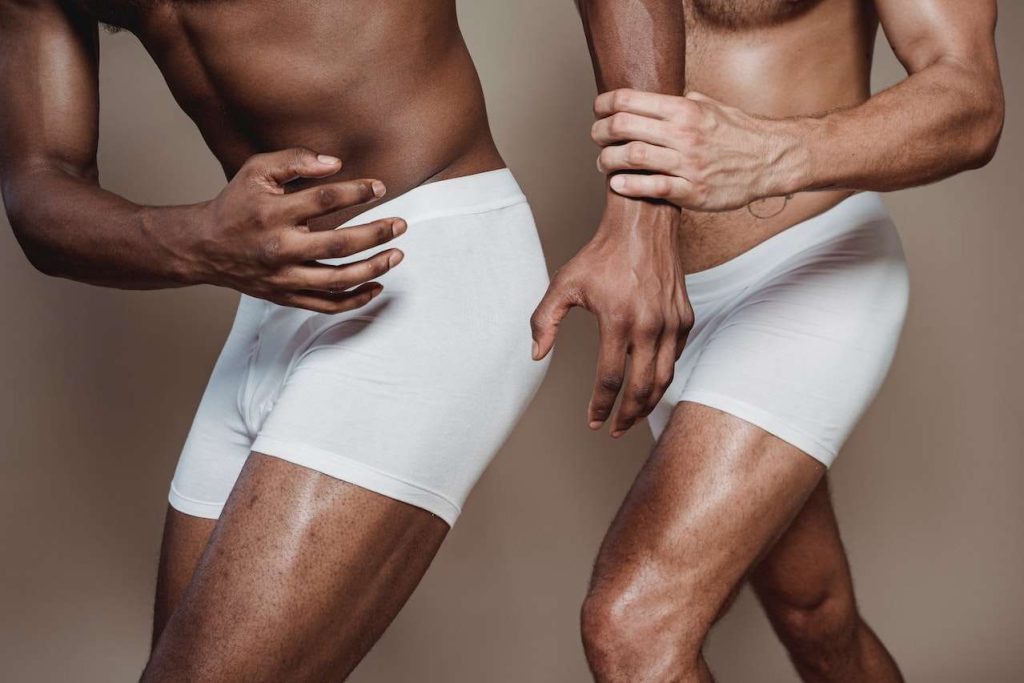When it comes to comfort, confidence, and style, one of the most underestimated factors is choosing the right size of men underwear. Ill-fitting underwear can lead to discomfort and even health issues. In this comprehensive guide, we will walk you through everything you need to know about men’s underwear sizes. From how to measure your size to determining if your underwear is too tight or loose, we’ve got you covered.
Content on this page:
- How do I know my underwear size?
- Size chart of men’s underwear
- Size chart for boys underwear based on age
- How do you know if undergarment is too small?
- How do you tell if underwear is too big?
- Can underpants stretch if you wear it a lot and can it shrink if you wash it too hot?
- Are there specific underwear styles that suit different body types and sizes?
- Correlates men underwear size to male organ size?
Answering Your Most Common Questions About Underwear Size For Men
Let’s dive into the world of men’s underwear size and discover the answers to the questions that matter most.
How do I know my underwear size?
The first step to finding the perfect underwear is knowing your size. Fortunately, measuring your underwear size is a straightforward process. All you need is a flexible measuring tape. Follow these steps:
- Stand up straight with your feet together.
- Do not wear clothes around your waist.
- Wrap the measuring tape around your waist, just above your hip bones.
- Make sure the tape is snug but not too tight.
- Note down the measurement in both inches and centimeters.
Additional Tips:
- Measure yourself when you’re relaxed and not holding your breath to ensure an accurate waist measurement.
- Double-check your measurement to avoid errors.
- If your waist measurement falls between sizes on the size chart, consider your personal comfort preferences. Some individuals prefer a slightly snugger fit, while others prefer a bit more room.
Size chart of men’s underwear
This chart should help you find the right size of men’s underwear based on your waist measurements, whether you prefer inches or centimeters. Remember to refer to the specific brand’s size chart when making your purchase, as sizing can sometimes vary between manufacturers.
| Underwear size | Waist Measurement | Waist Measurement |
|---|---|---|
| XS | 26-28 inches | 66-71 cm |
| S | 29-31 inches | 74-79 cm |
| M | 32-34 inches | 81-86 cm |
| L | 35-37 inches | 89-94 cm |
| XL | 38-40 inches | 97-102 cm |
Size chart for boys underwear based on age
For parents looking to purchase underwear for their growing boys, here’s a size chart that relates underwear sizes to age and waist measurements:
| Age Range | Size | Waist Measurement (Inches) | Waist Measurement (CM) |
|---|---|---|---|
| 2-4 years | XS | 19-21 | 48-53 |
| 4-6 years | XS | 21-22 | 53-56 |
| 6-8 years | XS | 22-23 | 56-58 |
| 8-10 years | S | 23-24 | 58-61 |
| 10-12 years | S | 24-25 | 61-64 |
| 12-14 years | M | 25-26 | 64-67 |
| 14-16 years | L | 26-27 | 67-70 |
It’s important to note that children grow at different rates, so it’s essential to measure the specific child’s waist to ensure the best fit. Keep in mind that kids grow quickly, so it’s a good idea to regularly check and update their underwear sizes.
Should boys wear tight or loose underwear?
When it comes to boys, comfort is key. It’s generally recommended that boys wear underwear that isn’t too tight or too loose. Tight underwear can be uncomfortable and restrict movement, while overly loose underwear may lead to chafing. Learn more below when underwear is to loose or tight.
How do you know if undergarment is too small?
Wearing underwear that’s too small can be uncomfortable and potentially harmful. Here are some signs that your underwear is too small:
- Excessive tightness and discomfort around the waistband and leg openings.
- The waistband digs into your skin, leaving marks.
- Fabric stretches excessively, making it see-through or causing it to tear.
If you notice any of these signs, it’s time to consider a larger size.
How do you tell if underwear is too big?
On the flip side, wearing underwear that is too big can be equally problematic. Here’s how you can tell if your underwear is too big:
- Constantly needing to pull up your underwear.
- Excess fabric bunching up around your waist or groin.
- The waistband sags and doesn’t sit comfortably at your waist.
If you experience any of these issues, it’s a clear indication that you should downsize to a smaller size.
Can underpants stretch if you wear it a lot and can it shrink if you wash it too hot?
Yes, underwear can experience changes in size due to wear and washing, depending on the materials used. Here’s how it can happen:
- Shrinking: If you wash underwear in hot water, especially if they are made from natural fibers like cotton, they are more prone to shrinking. Cotton has a tendency to contract when exposed to high temperatures.
- Stretching: On the other hand, underwear made from elastic materials like spandex or elastane can stretch out over time with wear. This is especially true if the elastic bands are repeatedly subjected to tension.
To prevent these issues and prolong the life of your underwear, consider the following tips:
- Follow Care Instructions: Always check the care instructions on the underwear label. They will provide guidance on the recommended washing temperature, drying method, and other care specifics.
- Use Cold Water: Washing your underwear in cold water is generally gentler on the fabric and helps prevent shrinking. It’s especially important for cotton underwear. Hygiene is important, so also clean it with hot water.
- Avoid Overdrying: Overdrying your underwear in a hot dryer can cause shrinkage, especially for cotton. Opt for a lower heat setting or air drying to prevent this.
- Avoid Fabric Softeners: Fabric softeners can break down the elastic fibers in underwear, causing them to lose their stretchiness. Consider using a detergent that’s suitable for delicates instead.
- Hand Washing: For delicate or special underwear, hand washing can be a gentle alternative to machine washing.
- Rotate Your Underwear: To minimize wear and tear, have a variety of underwear in your rotation. This reduces the frequency of wear for each pair.
- Buy Quality Brands: High-quality underwear is often made with materials and construction methods that resist stretching and shrinking. Investing in better brands can pay off in durability.
- Proper Storage: Store your underwear in a way that preserves their shape, such as neatly folding them or using specialized organizers.
By following these tips and being mindful of the care instructions, you can help prevent your underwear from shrinking or stretching out prematurely, regardless of the materials they are made from.

Are there specific underwear styles that suit different body types and sizes?
Yes, there are specific underwear styles that can complement different body types and sizes. Choosing the right underwear style can enhance comfort, support, and even your overall appearance. Here’s a guide on how various underwear styles can suit different body types:
1. Boxer Briefs
Best for: Most body types. Boxer briefs offer a balance between support and coverage, making them versatile and suitable for various body shapes. They are particularly great for those who want the comfort of boxers with the support of briefs.
2. Boxers
Best for: Slim to average body types. Boxers are loose-fitting and provide ample breathability, making them a good choice for those who prefer less compression. They can also accommodate a range of waist sizes.
3. Briefs underwear
Best for: Slim and athletic body types. Briefs offer excellent support and minimal coverage, making them ideal for those who want a sleek and minimalist look. They work well for those with a more slender physique.
4. Trunks
Best for: Athletic body types. Trunks are a shorter and more fitted version of boxer briefs. They offer support and a modern, stylish appearance, making them suitable for those with a well-defined physique.
5. Thongs
Best for: Confidence and comfort regardless of body type. Thongs are not limited to a specific body type but rather to those who prefer minimal coverage and are comfortable with this style. They can enhance a sense of self-assuredness and work under snug-fitting clothing.
6. Compression shorts
Best for: Athletic and muscular body types. Compression shorts are designed to provide extra support and muscle compression during sports and activities. They are often favored by athletes and those who engage in intense workouts.
7. Plus-Size Underwear
Best for: Larger body types. Several brands offer plus-size underwear with extended sizing to ensure comfort and fit for individuals with bigger body sizes. Look for styles like boxer briefs or briefs in these ranges.
8. High-Waisted Underwear
Best for: Those who want extra coverage around the waist area. High-waisted underwear can be flattering and comfortable for various body types, as they provide additional support and coverage for the midsection.
9. Low-Rise Underwear
Best for: Those who want to emphasize their hip area. Low-rise underwear sits lower on the waist and can be a fashionable choice for highlighting your hips and creating a modern look.
Ultimately, the best underwear style for you depends on your personal preferences, body type, and the level of support and coverage you desire. Experiment with different styles to find what makes you feel the most comfortable and confident.
Correlates men underwear size to male organ size?
Men’s underwear size is primarily determined by waist measurements and body shape, not male organ size. Underwear is designed to provide comfort, support, and coverage for the pelvic region, including the genitals, but it does not affect the size of the genitals themselves.
Learn more about other fashion sizes on our blog. For example, other undergarment like bra size.

